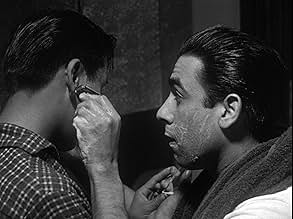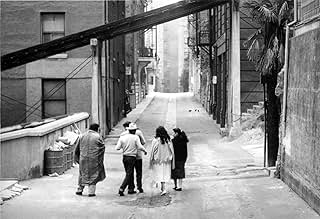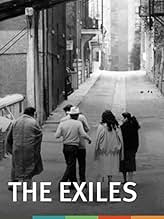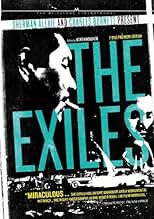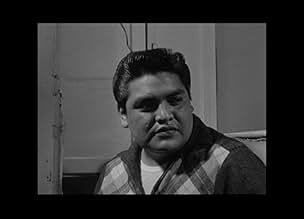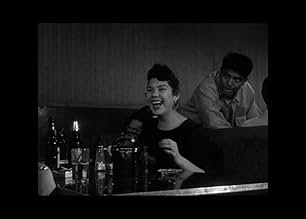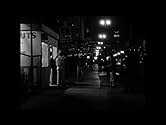IMDb RATING
6.6/10
1.5K
YOUR RATING
Follows a family of Native Americans living in the City of Angels.Follows a family of Native Americans living in the City of Angels.Follows a family of Native Americans living in the City of Angels.
- Awards
- 1 win total
Tom Reynolds
- Tommy
- (as Tommy Reynolds)
- Director
- Writer
- All cast & crew
- Production, box office & more at IMDbPro
Featured reviews
10muputony
Kent Mackenzie, USC Filmmaker, follows one 24 hr day of a native american couple and their friends in downtown Los Angeles, CA on & near Bunker Hill. With flashbacks to reservation life, the pathos of the "non-BIA approved" urban Indian life of poverty and utter hopelessness will move you beyond mere words. Homer & Yvonne are expecting a child - he is distant and lost, she abjectly passive and accepting of her fate. Absolutely real and so personal you may cry, knowing that nothing is going to get any better, and wishing that you could reach across time to make it different. Their child will be born in 1961-2 and is now age 40 if s/he survived.
Kent also made a film, "Bunker Hill" which followed an aged Doctor on his visits to patient's homes located on Bunker Hill area in Los Angeles where Homer & Yvonne lived. Scenes of Angel's Flight and old victorian buildings are in both films. Lost times and places now covered with corporate headquarters. Two American Tragedies.
Kent also made a film, "Bunker Hill" which followed an aged Doctor on his visits to patient's homes located on Bunker Hill area in Los Angeles where Homer & Yvonne lived. Scenes of Angel's Flight and old victorian buildings are in both films. Lost times and places now covered with corporate headquarters. Two American Tragedies.
This is a film that certainly won't appeal to the average person. However, despite this, it is an interesting and important film. The movie began as a school project at USC and eventually resulted in this small-time picture. It's about a group of displaced American-Indians who are living in Los Angelese. Unfortunately, their sense of purpose and work ethic have become lost in the transition from the reservation. This film documents a 24-hour stretch in their rather purposeless lives. As a piece of history and commentary it's very important stuff, though it's also the type stuff that is dreadfully dry. Seeing people going about their lives as you hear voice-overs and see dialog crudely inserted (it almost never matched the lip movements of the characters and was sloppy) becomes a bit of a drag after a while. A noble fictionalized documentary but one for which you really have to have a lot of patience in order to enjoy.
The Exiles by Kent Mackenzie, USA (Documentary). A 1961 documentary chronicling a day in the life of a group of twenty-something Native Americans who left reservation life in the 1950s to live in LA.
A unique and powerful film, blending storytelling with documentation. Mackenzie constructed a narrative about one day in the life of three main characters - a pregnant young woman (Yvonne), the father (Homer), and a man about town (Tommy). Both men are profound alcoholics, and the woman seems stunned by the circumstances of her life though hopeful for the future of her child.
The film opens with portraits from Edward Sheriff Curtis's monumental North American Indian, which I recommend as a starting place. Mackenzie has a sharp eye for cultural details - check out the Grand Hotel mattress in Yvonne and Homer's apartment, as well as the magazines, comics, advertisements, toys, and street scenes.
The story develops via voiceovers by Yvonne, Homer, and Tommy - and an amazing middle sequence from the rez, with generous doses of native language and music.
This is a must-see movie for anyone interested in social work, indigenous peoples, or the dark side of American culture. Never boring for any viewer.
A unique and powerful film, blending storytelling with documentation. Mackenzie constructed a narrative about one day in the life of three main characters - a pregnant young woman (Yvonne), the father (Homer), and a man about town (Tommy). Both men are profound alcoholics, and the woman seems stunned by the circumstances of her life though hopeful for the future of her child.
The film opens with portraits from Edward Sheriff Curtis's monumental North American Indian, which I recommend as a starting place. Mackenzie has a sharp eye for cultural details - check out the Grand Hotel mattress in Yvonne and Homer's apartment, as well as the magazines, comics, advertisements, toys, and street scenes.
The story develops via voiceovers by Yvonne, Homer, and Tommy - and an amazing middle sequence from the rez, with generous doses of native language and music.
This is a must-see movie for anyone interested in social work, indigenous peoples, or the dark side of American culture. Never boring for any viewer.
There are some real classics out there but you have to search with information from those who are in the know concerning great films and great filmmakers.
Kent MacKenzie gives us a 24-hour slice of the life of a young couple who moved from the reservation to Los Angeles in the 50s. I can go back and appreciate this now that I am older; much more than I would have at 11.
It is not a pretty picture. The men didn't work and spent their time drinking and gambling and hanging out. The wives were expected to feed them, clean their clothing, and give them what money they had.
There was a real fatalism in their voices and attitudes. Life was a party, and if things didn't work out, you could always go back to the reservation. Doing time? No problem, I do it outside, so I can do it inside.
Added to the National Film Registry this year, it is a slice of life that shows no promise.
Kent MacKenzie gives us a 24-hour slice of the life of a young couple who moved from the reservation to Los Angeles in the 50s. I can go back and appreciate this now that I am older; much more than I would have at 11.
It is not a pretty picture. The men didn't work and spent their time drinking and gambling and hanging out. The wives were expected to feed them, clean their clothing, and give them what money they had.
There was a real fatalism in their voices and attitudes. Life was a party, and if things didn't work out, you could always go back to the reservation. Doing time? No problem, I do it outside, so I can do it inside.
Added to the National Film Registry this year, it is a slice of life that shows no promise.
A belated attempt at an American neorealism or rather peaceful protest against the chintz and artifice of Hollywood with a document of the down and out who the movies were never about, either way this film about a group of young indians eking out a living in downtown Los Angeles is a rare artifact and an amazing find.
The lives; equal parts mundane and exciting, wearily enthusiastic at the prospect of another night where nothing but time flies and the same people are bolted down in the same bar stools. Beer bottles change hands over cheap formica counters, people dance, look around bored, smile at looking and being looked, saunter and stroll around aimless. During most of this the woman is back in a movie theater catching a late-night show. At some point the lights come up and intermission music plays from the speakers as sleepy patrons stretch and look around with drowsy eyes; it's that kind of movie. The moments no self-respecting Hollywood movie would bore its audience with, here strung up to see what kind of life they make up.
But most importantly, what precious, valuable poem about a Los Angeles that is no more. Not the Los Angeles imagined by Hollywood, the movie version as a fantastical den of iniquity where sultry femme fatales seduced schmucks in Spanish-style mansions. The real deal, where people lived. Cinema verite as it were, purporting the revelation of some truth in turn.
What truth here is all in the image. We can cobble together a view of the historic past but never before the invention of the camera lens did we have the actual thing rich with so much texture and detail, the magical contradiction of living ghosts (people or places).
Come to this not to be a told a story about these people. Ordinary anxieties of the displaced the same as everywhere else, the young and restless with too much time. Come to this to inhabit for a while, to sit around and listen. Compare with what LA we are thrown into 30 years later in Falling Down.
In the extras of the pristine restoration conducted by the UCLA, we find a 1956 student short about Bunker Hill, the neighborhood depicted. It's perhaps even better than the actual film. Interviewed are actual residents as we see footage of day-to-day lives, old men all about to be swept aside with their old world. They like to watch the public works constructed in the area, the ones will eventually push them out.
The lives; equal parts mundane and exciting, wearily enthusiastic at the prospect of another night where nothing but time flies and the same people are bolted down in the same bar stools. Beer bottles change hands over cheap formica counters, people dance, look around bored, smile at looking and being looked, saunter and stroll around aimless. During most of this the woman is back in a movie theater catching a late-night show. At some point the lights come up and intermission music plays from the speakers as sleepy patrons stretch and look around with drowsy eyes; it's that kind of movie. The moments no self-respecting Hollywood movie would bore its audience with, here strung up to see what kind of life they make up.
But most importantly, what precious, valuable poem about a Los Angeles that is no more. Not the Los Angeles imagined by Hollywood, the movie version as a fantastical den of iniquity where sultry femme fatales seduced schmucks in Spanish-style mansions. The real deal, where people lived. Cinema verite as it were, purporting the revelation of some truth in turn.
What truth here is all in the image. We can cobble together a view of the historic past but never before the invention of the camera lens did we have the actual thing rich with so much texture and detail, the magical contradiction of living ghosts (people or places).
Come to this not to be a told a story about these people. Ordinary anxieties of the displaced the same as everywhere else, the young and restless with too much time. Come to this to inhabit for a while, to sit around and listen. Compare with what LA we are thrown into 30 years later in Falling Down.
In the extras of the pristine restoration conducted by the UCLA, we find a 1956 student short about Bunker Hill, the neighborhood depicted. It's perhaps even better than the actual film. Interviewed are actual residents as we see footage of day-to-day lives, old men all about to be swept aside with their old world. They like to watch the public works constructed in the area, the ones will eventually push them out.
Did you know
- TriviaKent Mackenzie borrowed equipment from industrial film makers Parthenon Pictures and used the unused "ends" of thousand-foot reels of 35mm film, according to an article in the 12 March 1961 edition of the New York Times.
- GoofsIn a scene where an older man is heard singing and playing an instrument under a tree, he is not doing corresponding actions in a long-shot.
- ConnectionsFeatured in Los Angeles Plays Itself (2003)
- How long is The Exiles?Powered by Alexa
Details
- Release date
- Country of origin
- Official site
- Language
- Also known as
- Изгнанники
- Filming locations
- See more company credits at IMDbPro
Box office
- Budget
- $539 (estimated)
- Gross US & Canada
- $30,945
- Opening weekend US & Canada
- $8,448
- Jul 13, 2008
- Gross worldwide
- $30,945
- Runtime
- 1h 12m(72 min)
- Color
- Sound mix
- Aspect ratio
- 1.37 : 1
Contribute to this page
Suggest an edit or add missing content


